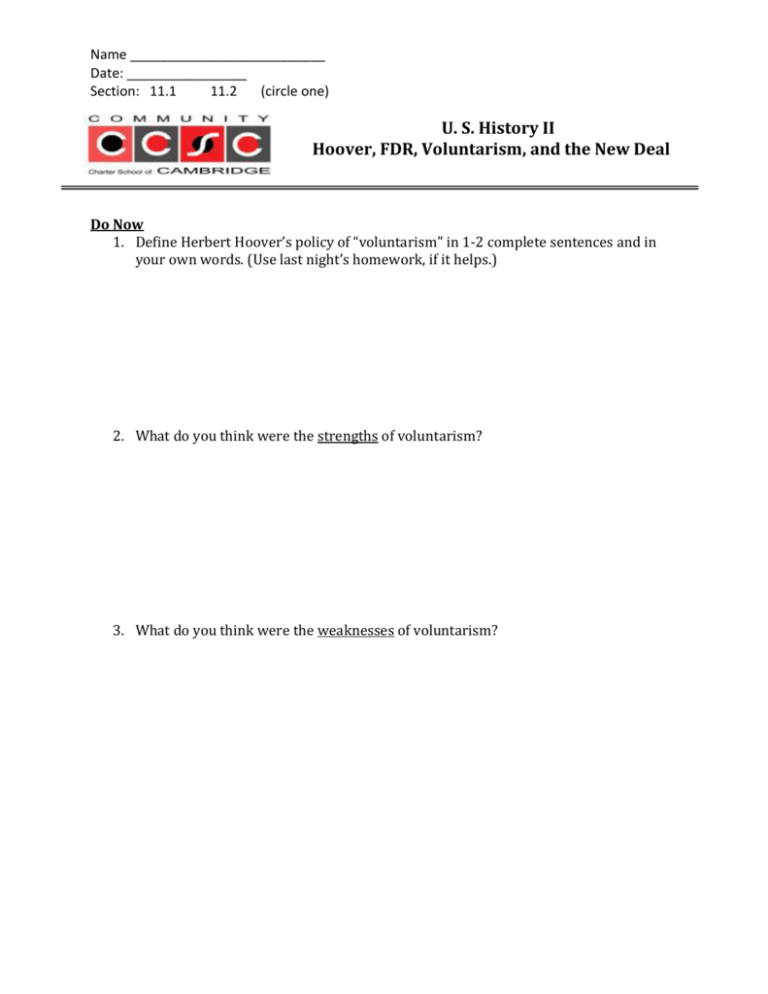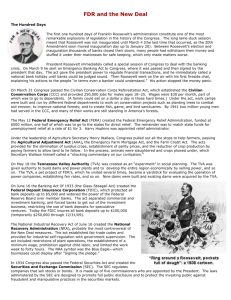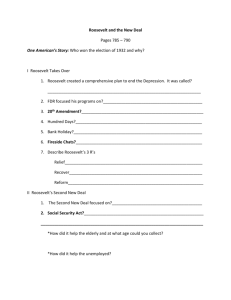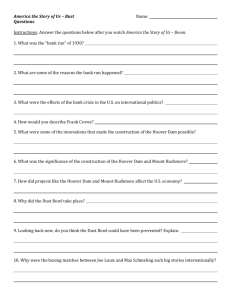
Name __________________________
Date: ________________
Section: 11.1
11.2
(circle one)
U. S. History II
Hoover, FDR, Voluntarism, and the New Deal
Do Now
1. Define Herbert Hoover’s policy of “voluntarism” in 1-2 complete sentences and in
your own words. (Use last night’s homework, if it helps.)
2. What do you think were the strengths of voluntarism?
3. What do you think were the weaknesses of voluntarism?
Exit Ticket
In one well-constructed paragraph [at least 7 complete sentences], explain the difference
between Hoover’s and Roosevelt’s approaches to solving the Great Depression. Your
answer should make reference to specific philosophies and policies associated with each
president.
Name __________________________
Date: ________________
Section: 11.1
11.2
(circle one)
U. S. History II
HW 6.7: The New Deal
Important Note: This homework is due on Monday, March 24.
Even More Important Note: You are also responsible for finishing a rough draft of
your roundtable artifact reflection by Monday, March 24. (We will work on this in
your next class.)
Instructions
1. Carefully read the following text (source: Emma Lapsansky-Werner et al., United
States History [Boston: Pearson Prentice Hall, 2008]).
2. Use the reading and your lecture notes to update the identification and mind map
for “The New Deal” in your study guide.
3. In your own words, on a separate sheet of paper, answer the following questions in
at least two complete sentences each:
a. How did Roosevelt help stop bank panics?
b. What was the TVA, and how did it address the Depression?
c. What was the NRA, and how did it address the Depression?
d. What was the WPA, and how did it address the Depression?
e. What was Social Security, and how did it address the Depression?
4. Answer the following in one well-constructed paragraph [at least 5 sentences]: How
did Roosevelt’s policies for solving the Depression differ from those of Herbert
Hoover?
The First Hundred Days Provide Instant Action
During his first hundred days in office, Roosevelt proposed and Congress passed 15 bills.
These measures, known as the First New Deal, had three goals: relief, recovery, and
reform. Roosevelt wanted to provide relief from the immediate hardships of the depression
and achieve a long-term economic recovery. He also instituted reforms to prevent future
depressions.
FDR Swiftly Restores the Nation’s Confidence
Roosevelt wasted no time dealing with the nation’s number one crisis. Late in 1932, banks
had begun to fail in great numbers. A banking panic gripped the nation as frightened
depositors lined up outside banks, trying to withdraw their savings.
The day after his inauguration, Roosevelt called Congress into a special session and
convinced them to pass laws to shore up the nation’s banking system. The Emergency
Banking Bill gave the President broad powers—including the power to declare a four-day
bank “holiday.” Banks all over the country were ordered to close. The closings gave banks
time to get their accounts in order before they reopened for business.
Eight days after becoming President, Roosevelt delivered an informal radio speech to the
American people. This was the first of many presidential fireside chats. They became an
important way for Roosevelt to communicate with the American people. In the first fireside
chat, FDR explained the measures he had taken to stem the run on banks. His calming
words reassured the American people. When the bank holiday ended, Americans did not
rush to their banks to withdraw their funds. Roosevelt had convinced them that the banks
were a safe place to keep their money.
Reforming the Financial System
A number of Roosevelt’s proposals sought to reform the nation’s financial institutions. One
act created the Federal Deposit Insurance Corporation (FDIC), which insured bank
deposits up to $5,000. In the following year, Congress established the Securities and
Exchange Commission (SEC) to regulate the stock market and make it a safer place for
investments.
These financial reforms helped restore confidence in the economy. Runs on banks ended,
largely because Americans now had confidence that they would not lose their lifetime
savings if a bank failed. The stock markets also stabilized as regulated trading practices
reassured investors.
The TVA Aids Rural Southerners
Americans living in the Tennessee River valley were among the poorest in the nation. Few
had electricity, running water, or proper sewage systems. In 1933, Congress responded by
creating a government agency called the Tennessee Valley Authority (TVA). The TVA
built a series of dams in the Tennessee River valley to control floods and to generate
electric power. The agency also replanted forests, built fertilizer plants, created jobs, and
attracted industry with the promise of cheap power.
Despite its accomplishments, the TVA attracted a host of critics. Some called the TVA
“socialist,” because it gave government direct control of a business. Private power
companies complained that they could not compete with the TVA, because the agency paid
no taxes. However, the TVA’s successes in improving life in the Tennessee Valley have
ensured its survival to the present.
Providing Relief and Promoting Industrial Recovery
During his first hundred days as President, Roosevelt proposed and Congress enacted
numerous other relief measures. To counter the depression’s devastating impact on young
men, FDR created the Civilian Conservation Corps (CCC). The CCC provided jobs for more
than 2 million young men. They replanted forests, built trails, dug irrigation ditches, and
fought fires. As time went on, programs such as the CCC became more inclusive, extending
work and training to Mexican American and other minority youth, as well as to whites. FDR
called the CCC his favorite New Deal program.
Congress passed a number of other relief acts. The Federal Emergency Relief Act (FERA)
granted federal funds to state and local agencies to help the unemployed. The short-lived
Civil Works Administration (CWA) provided jobs on public-works projects. On another
front, Congress created the Home Owners Loan Corporation (HOLC), which loaned money
at low interest rates to homeowners who could not meet mortgage payments. The Federal
Housing Administration (FHA) insured bank loans used for building and repairing homes.
These New Deal measures marked a clear break from the policies of the Hoover
administration, which had disapproved of direct relief to individuals. The $500 million
appropriated for FERA represented the largest peacetime expenditure by the federal
government to that time.
The centerpiece of the early New Deal’s recovery program was the National Industrial
Recovery Act, which established the National Recovery Administration (NRA). Roosevelt
called the NIRA “the most important and far-reaching legislation ever enacted by the
American Congress.” Working with business and labor leaders, the NRA developed codes of
fair competition to govern whole industries. These codes established minimum wages for
workers and minimum prices for the goods that businesses sold. The idea behind these
codes was to increase the wages of workers so they could buy more goods and raise prices
so companies could make a profit.
Another New Deal legislative achievement was the Public Works Administration (PWA),
which built bridges, dams, power plants, and government buildings. The PWA was
responsible for building many important projects still in use today, such as New York City’s
Triborough Bridge, the Overseas Highway linking Miami and Key West, and the Bonneville
Dam on the Columbia River in the Pacific Northwest. These public-works projects
improved the nation’s infrastructure and created millions of new jobs for workers.
Extending Social and Economic Reform
In his fireside chats, press conferences, and major addresses, Roosevelt explained the
challenges facing the nation. He said that the complexities of the modern world compelled
the federal government to “promote the general welfare” and to intervene to protect
citizens’ rights. Roosevelt used legislation passed during the Second New Deal to
accomplish these goals. The Second New Deal addressed the problems of the elderly, the
poor, and the unemployed; created new public-works projects; helped farmers; and
enacted measures to protect workers’ rights. It was during this period that the first serious
challenges to the New Deal emerged.
New Programs Provide Jobs
In the spring of 1935, Congress appropriated $5 billion for new jobs and created the Works
Progress Administration (WPA) to administer the program. Roosevelt placed his
longtime associate Harry Hopkins in charge. The WPA built or improved a good part of the
nation’s highways, dredged rivers and harbors, and promoted soil and water conservation.
The WPA even provided programs in the arts for displaced artists. As Hopkins explained,
artists “have to eat just like other people.”
By 1943, the WPA had employed more than 8 million people and spent about $11 billion.
Its workers built more than 650,000 miles of highways and 125,000 public buildings.
Among the most famous projects funded by the WPA were the San Antonio River Walk and
parts of the Appalachian Trail.
All of these programs were expensive, and the government paid for them by spending
money it did not have. The federal deficit—$461 million in 1932—grew to $4.4 billion in
1936. The enormous expenditures and growing debt led many to criticize the government’s
public-works projects as wasteful. Some economists disagreed. British economist John
Maynard Keynes argued that deficit spending was needed to end the depression.
According to Keynes, putting people to work on public projects put money into the hands of
consumers who would buy more goods, stimulating the economy. Keynes called this theory
pump priming.
Social Security Eases the Burden on Older Americans
The United States was one of the few industrialized nations in the world that did not have
some form of pension system for the elderly. During the depression, many elderly people
had lost their homes and their life savings and were living in poverty. On January 17, 1935,
President Roosevelt unveiled his plans for Social Security.
In addition to creating a pension system for retirees, the Social Security Act that Congress
enacted established unemployment insurance for workers who lost their jobs. The law also
created insurance for victims of work-related accidents and provided aid for povertystricken mothers and children, the blind, and the disabled.
The Social Security Act had many flaws. At first, it did not apply to domestics or
farmworkers. Since African Americans were disproportionately employed in these fields,
they were not eligible for many of the benefits of Social Security. Widows received smaller
benefits than widowers, because people presumed that elderly women could manage on
less money than elderly men. Despite these shortcomings, Social Security proved the most
popular and significant of the New Deal programs.








